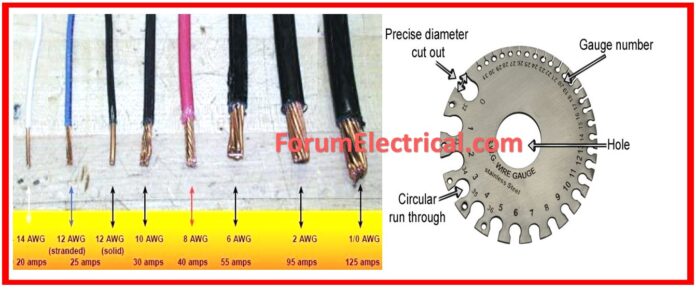This Excel tool is intended to assist you in determining electrical wire sizes in terms of the AWG, Metric wire specification IEC 60228 as well as the UK’s BS 3737. It also provides such parameters as the wire diameter, the cross-sectional profile area etc.
Overview
Sizing and specification of electrical wires are very important for the purpose of providing safe electrical installations.
These specifications are dependent on a number of standards such as the American Wire Gauge, metric and standard British units.
The below post explains the different wire sizes, wires diameter, cross-sectional area and features of the wires.
NEC Code & Standard & AWG Standards
There is a specific code governing all electrical installations by the NEC as stated in the NFPA 70 where wire sizes are classified based on their AWG rating.
The AWG system is a wire gauge system to be used in North America that has small gauge numbers as a bigger diameter of the wire.
Below is a summary of wire sizes from 2000 MCM (Kcmil) down to 30 AWG, including their corresponding diameters in mils, inches, and millimeters, as well as their cross-sectional areas in circular mils (cmils) and square millimeters (mm²):
- 2000 MCM (Kcmil): 1. 414 inches (35. 92mm), 1,999,396cmils or 1013. 11 mm²
- 1000 MCM (Kcmil): 1. 0 gauge (. 0254 mm), 1 micro inch, 508. 71 mm²
- 4/0 AWG: 0. 460 inches (11. 68 mm), 211,600 cmils, sq. 22 mm²
- 30 AWG: 0. micron, 25 micron, 0. 010 inch, 100 cmils. 05 mm²
These are some of the wire sizes applied in various uses based on the current rating needed and other conditions of the wiring system.
Metric Wire Specification: IEC 60228
This is the IEC 60228 circular conductor cables whose technical specifications are based on the metric system prevalent in Europe and other parts of the world.
This standard gives the cross sectional area of the wires in square millimeters (mm²) and is important for international compatibility and protection.
British Wire Specification: BS 3737
The British Wire Specification was conventionally described under BS 3737, which has recently been replaced by the metric standard.
Though it is not so widely used now, it is still quite useful for understanding certain historical specifications and while working with specific systems.
Electrical Wire Size Calculator
Input
Wire Size (AWG/MCM): Insert the wire size here. It takes inputs in the range of 2000 MCM to 30 AWG.
System Standard: Specify calculation based on the chosen standard:
AWG (NFPA 70, NEC): Because the actual wire size is a range, rather than a definitive thickness, AWG is the obvious choice to use.
Metric (IEC 60228): Metric wire specification.
British (BS 3737): BS 19 Specification for British wire (the standard has since been replaced by the metric standard).
Calculation
This section automatically calculates the following parameters based on the input:
Diameter
- Mils: The diameter of a single wire in mils, thousandths of an inch.
- Inches: An increase in the logarithm of the wire diameter in inches.
- Millimeters (mm): The diameter of the wire in millimeters in which the parameter was made at the time of testing.
Cross-Sectional Area
- Circular Mils (cmils): A physical parameter equaling the cross-sectional area in circular mil units.
- Square Millimeters (mm²): Here cross sectional area defined in square millimeters.
Output
Results Display: This part of the website shows the calculated wire diameter and cross-sectional area according to the wire size that the user entered as well as the selected standard.
As indicated on the wire label, this section presents quick and easy information on the electrical properties of the wire.
Instructions for Use
Type the size of wire and click on enable via the preferred standard.
Check the obtained diameter and area of cross-section.
It is possible to apply the standard conversion feature, if necessary.
For inputs see that they are all within a valid range to avoid getting erroneous results.
Excel Calculator
Combined with the given metric and British standards, the AWG system gives electrical wire users the proper measurement tools required for making precise and accurate wire selection to address any given application, with due consideration to safety and competent performance of the electrical installations.
Click here for more Electrical Calculators









